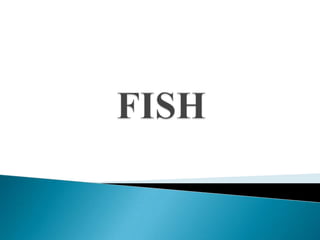
Culinary lecture (fish)
- 2. Fishis used to refer to any aquatic vertebrate that has a skin covered with scales, two sets of paired fins, some unpaired fins, and a set of gills. Fish do not represent a single clade but are instead paraphyletic. They include hagfishes, lampreys, lobe-finned fishes, cartilaginous fishes and ray-finned fishes.
- 3. Their condition when purchased: frozen, chilled, canned, smoked, salted. ‘wet’: meaning fresh as opposed to salted Where they come from: sea, or freshwater, farmed or wild (e.g. salmon), exotic (imported from all corners of the world: examples include snapper, shark, parrotfish and tuna). Freshwater fish are sometimes divided into river and lake fish.
- 4. But perhaps the most useful way of classifying fish for caterers is: By their shape, whether they are flat or round By the general characteristics of their flesh, whether they are white or oil-rich
- 5. Flat fish such as sole and plaice, because of their shape, are filleted in a different way from round fish, such as cod, hake, whiting, salmon and herring. The flesh of the last two examples, salmon and herring, has a different and easily detectable characteristic: it is oily. Other oily fish are mackerel, tuna, anchovy and sardine, quite different in flavor and taste from white fish such as turbot and halibut.
- 6. Eyes-Fish are visual predators. Many nocturnal fish have large eyes to help them feed at night. Operculum-is the bony flap that covers a fish's gills. Lateral line-runs along the sides of a fish's body. It is used as a sensory organ by the fish.
- 7. Fins-are used for swimming and sometimes for protection. Some fins are paired and others unpaired. Fins are most bony fish are flexible and supported by visible spines and rays. Tail-the shape of the tail can be an indicator of how fast a fish usually swims. Gills-Oxygen enters the bloodstream and carbon dioxide diffuses out at the gills, which are feathery structures found along the sides of the head.
- 8. Skin-the skin of most bony fish is covered with bony scales that look like shingles on a roof. Bony fish scales are waterproof and help protect the fish.
- 9. Food Nutrition in Fish Fish and seafood should form a major part of any healthy diet. It is an excellent source of protein, a vital source of essential fatty acids and contains a wide variety of vitamins and minerals. It is also low in calories which make it perfect for any weight loss eating plan.
- 10. Energy in Fish White fish such as cod, haddock, plaice and sole contains about 100 calories (100 grams), while oily fish such as herring, mackerel, salmon and sardines contains about 130-240 calories (100 grams).
- 11. Nutrients in Fish Cod contains about 20 percent protein, no carbs and about 1g of fat. Mackerel contains about 20 percent protein, no carbs and 15 percent fat. Vitamins in Fish The Vitamin content of fish varies according to species. Cod and haddock are rich in Vitamins A and D, while tuna is rich in Vitamin D and B12. Salmon and trout are rich in Vitamins A, B12 and D.
- 12. Whole or Round-fish are those marketed just as they come from the water. Drawn-fish are marketed with only the entrails removed. Dressed-fish are scaled eviscerated, usually with the head, tail and fins removed.
- 13. Steaks-are cross-section slices of the larger sizes of dressed fish. A cross-section of the backbone, usually the only bone in the steak. Fillet-the sides of the fish, cut lengthwise away from the backbone. They are practically boneless and require no preparation for cooking. Butterfly Fillet-are the two sides of the fish corresponding to two single fillets held together by uncut flesh and the skin.
- 14. Sticks-are pieces of fish cut lengthwise or crosswise from fillets or steaks into portions of uniform width and length.
- 15. Dry cooking methods oFrying oGrilling obaking Wet cooking methods oPoaching oSteaming oBoiling
- 16. Croaker -Alakaak Long-jawed Mackerel-Alumahan Sea bass-Apahap
- 20. Yellow tail fusilier -Dalagang bukid Rabbit fish-Danggit Indian halibut-Dapa
- 21. Anchovy –Dilis Dolphin fish-Dorado Sea snake-Duhol
- 22. Beltfish-Espada Hard-tail mackerel; Round scad – Galunggong Oil fish-Gindara
- 24. Flying fish- Isdang lawin Mackerel-Japayuki Salmon catfish- Kanduli
- 26. Black or white marlin-Malasugui Wrasse-Maming Purse-eyed scad-Matang baka
- 27. Tilefish- Matang-dagat Sailfish-Matumbok Red snapper -Maya-maya
- 28. Tilapia bigger than 1 kg-Pla-pla Pony fish-Sapsap Smooth-tailed trevally-Salay-salay
- 29. Manta orsting ray- Pagi Eel-Palos Pomfret-Pampano
- 30. Mistichthys Luzonensi-Sinarapan Skipjack tuna- Tambakol Sardinella-Tamban
- 32. Carla May P. Pruna Mara C. Cabuyao Analiza M. Amandy Viron C. Chumacera